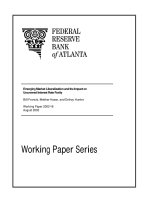Upper and Lower Bounds on Put Option
Bạn đang xem bản rút gọn của tài liệu. Xem và tải ngay bản đầy đủ của tài liệu tại đây (235.75 KB, 28 trang )
Lecture 7
Sergei Fedotov
20912 - Introduction to Financial Mathematics
Sergei Fedotov (University of Manchester)
20912
2010
1/8
Lecture 7
1
Upper and Lower Bounds on Put Options
2
Proof of Put-Call Parity by No-Arbitrage Principle
3
Example on Arbitrage Opportunity
Sergei Fedotov (University of Manchester)
20912
2010
2/8
Upper and Lower Bounds on Put Option
Reminder from lecture 6.
• Arbitrage opportunity arises when a zero initial investment Π0 = 0 is
identified that guarantees a non-negative payoff in the future such that
ΠT > 0 with non-zero probability.
Sergei Fedotov (University of Manchester)
20912
2010
3/8
Upper and Lower Bounds on Put Option
Reminder from lecture 6.
• Arbitrage opportunity arises when a zero initial investment Π0 = 0 is
identified that guarantees a non-negative payoff in the future such that
ΠT > 0 with non-zero probability.
• Put-Call Parity at time t = 0:
Sergei Fedotov (University of Manchester)
S0 + P0 − C0 = Ee −rT .
20912
2010
3/8
Upper and Lower Bounds on Put Option
Reminder from lecture 6.
• Arbitrage opportunity arises when a zero initial investment Π0 = 0 is
identified that guarantees a non-negative payoff in the future such that
ΠT > 0 with non-zero probability.
• Put-Call Parity at time t = 0:
S0 + P0 − C0 = Ee −rT .
Upper and Lower Bounds on Put Option (exercise sheet 3):
Ee −rT − S0 ≤ P0 ≤ Ee −rT
Let us illustrate these bounds geometrically.
Sergei Fedotov (University of Manchester)
20912
2010
3/8
Proof of Put-Call Parity
The value of European put option can be found as
P0 = C0 − S0 + Ee −rT .
Let us prove this relation by using No-Arbitrage Principle.
Sergei Fedotov (University of Manchester)
20912
2010
4/8
Proof of Put-Call Parity
The value of European put option can be found as
P0 = C0 − S0 + Ee −rT .
Let us prove this relation by using No-Arbitrage Principle.
Assume that P0 > C0 − S0 + Ee −rT . Then one can make a riskless profit
(arbitrage opportunity).
Sergei Fedotov (University of Manchester)
20912
2010
4/8
Proof of Put-Call Parity
The value of European put option can be found as
P0 = C0 − S0 + Ee −rT .
Let us prove this relation by using No-Arbitrage Principle.
Assume that P0 > C0 − S0 + Ee −rT . Then one can make a riskless profit
(arbitrage opportunity).
We set up the portfolio Π = −P − S + C + B. At time t = 0 we
• sell one put option for P0 (write the put option)
Sergei Fedotov (University of Manchester)
20912
2010
4/8
Proof of Put-Call Parity
The value of European put option can be found as
P0 = C0 − S0 + Ee −rT .
Let us prove this relation by using No-Arbitrage Principle.
Assume that P0 > C0 − S0 + Ee −rT . Then one can make a riskless profit
(arbitrage opportunity).
We set up the portfolio Π = −P − S + C + B. At time t = 0 we
• sell one put option for P0 (write the put option)
• sell one share for S0 (short position)
Sergei Fedotov (University of Manchester)
20912
2010
4/8
Proof of Put-Call Parity
The value of European put option can be found as
P0 = C0 − S0 + Ee −rT .
Let us prove this relation by using No-Arbitrage Principle.
Assume that P0 > C0 − S0 + Ee −rT . Then one can make a riskless profit
(arbitrage opportunity).
We set up the portfolio Π = −P − S + C + B. At time t = 0 we
• sell one put option for P0 (write the put option)
• sell one share for S0 (short position)
• buy one call option for C0
Sergei Fedotov (University of Manchester)
20912
2010
4/8
Proof of Put-Call Parity
The value of European put option can be found as
P0 = C0 − S0 + Ee −rT .
Let us prove this relation by using No-Arbitrage Principle.
Assume that P0 > C0 − S0 + Ee −rT . Then one can make a riskless profit
(arbitrage opportunity).
We set up the portfolio Π = −P − S + C + B. At time t = 0 we
• sell one put option for P0 (write the put option)
• sell one share for S0 (short position)
• buy one call option for C0
• buy one bond for B0 = P0 + S0 − C0 > Ee −rT
Sergei Fedotov (University of Manchester)
20912
2010
4/8
Proof of Put-Call Parity
The value of European put option can be found as
P0 = C0 − S0 + Ee −rT .
Let us prove this relation by using No-Arbitrage Principle.
Assume that P0 > C0 − S0 + Ee −rT . Then one can make a riskless profit
(arbitrage opportunity).
We set up the portfolio Π = −P − S + C + B. At time t = 0 we
• sell one put option for P0 (write the put option)
• sell one share for S0 (short position)
• buy one call option for C0
• buy one bond for B0 = P0 + S0 − C0 > Ee −rT
The balance of all these transactions is zero, that is, Π0 = 0
Sergei Fedotov (University of Manchester)
20912
2010
4/8
Proof of Put-Call Parity
At maturity t = T the portfolio Π = −P − S + C + B has the value
ΠT =
−(E − S) − S + B0 e rT ,
−S + (S − E ) + B0 e rT ,
Sergei Fedotov (University of Manchester)
20912
S ≤ E,
= −E + B0 e rT
S > E,
2010
5/8
Proof of Put-Call Parity
At maturity t = T the portfolio Π = −P − S + C + B has the value
ΠT =
−(E − S) − S + B0 e rT ,
−S + (S − E ) + B0 e rT ,
S ≤ E,
= −E + B0 e rT
S > E,
Since B0 > Ee −rT , we conclude ΠT > 0. and Π0 = 0.
This is an arbitrage opportunity.
Sergei Fedotov (University of Manchester)
20912
2010
5/8
Proof of Put-Call Parity
Now we assume that P0 < C0 − S0 + Ee −rT .
We set up the portfolio Π = P + S − C − B.
Sergei Fedotov (University of Manchester)
20912
2010
6/8
Proof of Put-Call Parity
Now we assume that P0 < C0 − S0 + Ee −rT .
We set up the portfolio Π = P + S − C − B.
At time t = 0 we
• buy one put option for P0
Sergei Fedotov (University of Manchester)
20912
2010
6/8
Proof of Put-Call Parity
Now we assume that P0 < C0 − S0 + Ee −rT .
We set up the portfolio Π = P + S − C − B.
At time t = 0 we
• buy one put option for P0
• buy one share for S0 (long position)
Sergei Fedotov (University of Manchester)
20912
2010
6/8
Proof of Put-Call Parity
Now we assume that P0 < C0 − S0 + Ee −rT .
We set up the portfolio Π = P + S − C − B.
At time t = 0 we
• buy one put option for P0
• buy one share for S0 (long position)
• sell one call option for C0 (write the call option)
Sergei Fedotov (University of Manchester)
20912
2010
6/8
Proof of Put-Call Parity
Now we assume that P0 < C0 − S0 + Ee −rT .
We set up the portfolio Π = P + S − C − B.
At time t = 0 we
• buy one put option for P0
• buy one share for S0 (long position)
• sell one call option for C0 (write the call option)
• borrow B0 = P0 + S0 − C0 < Ee −rT
Sergei Fedotov (University of Manchester)
20912
2010
6/8
Proof of Put-Call Parity
Now we assume that P0 < C0 − S0 + Ee −rT .
We set up the portfolio Π = P + S − C − B.
At time t = 0 we
• buy one put option for P0
• buy one share for S0 (long position)
• sell one call option for C0 (write the call option)
• borrow B0 = P0 + S0 − C0 < Ee −rT
The balance of all these transactions is zero, that is, Π0 = 0
At maturity t = T we have ΠT = E − B0 e rT . Since B0 < Ee −rT , we
conclude ΠT > 0.
This is an arbitrage opportunity!!!
Sergei Fedotov (University of Manchester)
20912
2010
6/8
Example on Arbitrage Opportunity
Three months European call and put options with the exercise price £12
are trading at £3 and £6 respectively.
The stock price is £8 and interest rate is 5%. Show that there exists
arbitrage opportunity.
Sergei Fedotov (University of Manchester)
20912
2010
7/8
Example on Arbitrage Opportunity
Three months European call and put options with the exercise price £12
are trading at £3 and £6 respectively.
The stock price is £8 and interest rate is 5%. Show that there exists
arbitrage opportunity.
Solution:
The Put-Call Parity P0 = C0 − S0 + Ee −rT is violated, because
1
6 < 3 − 8 + 12e −0.05× 4 = 6.851
Sergei Fedotov (University of Manchester)
20912
2010
7/8
Example on Arbitrage Opportunity
Three months European call and put options with the exercise price £12
are trading at £3 and £6 respectively.
The stock price is £8 and interest rate is 5%. Show that there exists
arbitrage opportunity.
Solution:
The Put-Call Parity P0 = C0 − S0 + Ee −rT is violated, because
1
6 < 3 − 8 + 12e −0.05× 4 = 6.851
To get arbitrage profit we
• buy a put option for £6
• sell a call option for £3
Sergei Fedotov (University of Manchester)
20912
2010
7/8
Example on Arbitrage Opportunity
Three months European call and put options with the exercise price £12
are trading at £3 and £6 respectively.
The stock price is £8 and interest rate is 5%. Show that there exists
arbitrage opportunity.
Solution:
The Put-Call Parity P0 = C0 − S0 + Ee −rT is violated, because
1
6 < 3 − 8 + 12e −0.05× 4 = 6.851
To get arbitrage profit we
• buy a put option for £6
• sell a call option for £3
• buy a share for £8
Sergei Fedotov (University of Manchester)
20912
2010
7/8
Example on Arbitrage Opportunity
Three months European call and put options with the exercise price £12
are trading at £3 and £6 respectively.
The stock price is £8 and interest rate is 5%. Show that there exists
arbitrage opportunity.
Solution:
The Put-Call Parity P0 = C0 − S0 + Ee −rT is violated, because
1
6 < 3 − 8 + 12e −0.05× 4 = 6.851
To get arbitrage profit we
• buy a put option for £6
• sell a call option for £3
• buy a share for £8
• borrow £11 at the interest rate 5%.
The balance is zero!!
Sergei Fedotov (University of Manchester)
20912
2010
7/8









